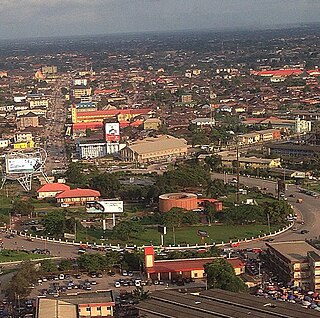
Benin City is the capital and largest city of Edo State, southern Nigeria. In central Kings square, the Benin city National Museum traces the Benin empire and has displays of terracotta sculpture. The Oba's palace is known for bronze plaques that once decorated with the walls, depicting historical events and Life at court. It is the fourth-largest city in Nigeria according to the 2006 census, after Lagos, Kano, and Ibadan. It is situated approximately 40 kilometres (25 mi) north of the Benin River and 320 kilometres (200 mi) by road east of Lagos. Benin City is the centre of Nigeria's rubber industry, and oil production is also a significant industry.

The Oba of Benin is the traditional ruler and the custodian of the culture of the Edo people and all Edoid people. The then Kingdom of Benin has continued to be mostly populated by the Edo.
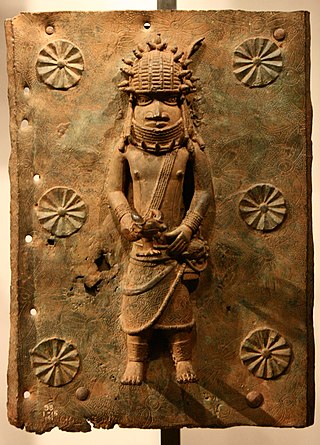
The Benin Bronzes are a group of several thousand metal plaques and sculptures that decorated the royal palace of the Kingdom of Benin, in what is now Edo State, Nigeria. Collectively, the objects form the best examples of Benin art and were created from the thirteenth century by artists of the Edo people. The plaques, which in the Edo language are called Ama, depict scenes or represent themes in the history of the kingdom. Apart from the plaques, other sculptures in brass or bronze include portrait heads, jewelry, and smaller pieces.

Ewuare was the Oba (king) of the Benin Empire from 1440 until 1473. Ewuare became king in a violent coup against his brother Uwaifiokun which destroyed much of Benin City. After the war, Ewuare rebuilt much of the city of Benin, reformed political structures in the kingdom, greatly expanded the territory of the kingdom, and fostered the arts and festivals. He left a significant legacy and is often considered the first King of the Kingdom of Benin.

Most African sculpture was historically in wood and other organic materials that have not survived from earlier than at most a few centuries ago; older pottery figures are found from a number of areas. Masks are important elements in the art of many peoples, along with human figures, often highly stylized. There is a vast variety of styles, often varying within the same context of origin depending on the use of the object, but wide regional trends are apparent; sculpture is most common among "groups of settled cultivators in the areas drained by the Niger and Congo rivers" in West Africa. Direct images of African deities are relatively infrequent, but masks in particular are or were often made for traditional African religious ceremonies; today many are made for tourists as "airport art". African masks were an influence on European Modernist art, which was inspired by their lack of concern for naturalistic depiction.

Oba Esigie was the son of Oba Ozolua, who reigned in the late 15th century, and his second wife, Queen Idia. Oba Esigie ruled the ancient Benin Kingdom, now Benin City, Edo State, Nigeria. Works of art commissioned by Esigie are held in prominent museums including the Metropolitan Museum of Art and the British Museum.

Idia was the mother of Esigie, who reigned as Oba (king) of the Edo people from 1504 to 1550. Historians do know that Idia was alive during the Idah war because she played a role that led to a great Benin victory. It has been argued that Idia, therefore, was the true power behind the throne of her son. She played a significant role in the rise and reign of her son, being described as a great warrior who fought relentlessly before and during her son's reign as the Oba (king) of the Edo people. Queen Idia was instrumental in securing the title of Oba for her son Esigie following the death of his father Oba Ozolua. To that end, she raised an army to fight off his brother Arhuaran who was supposed to be the Oba by right and tradition but was subsequently defeated in battle. Esigie’s mother became the 17th Oba of Benin.

Benin art is the art from the Kingdom of Benin or Edo Empire (1440–1897), a pre-colonial African state located in what is now known as the Southern region of Nigeria. Primarily made of cast bronze and carved ivory, Benin art was produced mainly for the court of the Oba of Benin – a divine ruler for whom the craftsmen produced a range of ceremonially significant objects. The full complexity of these works can be appreciated through the awareness and consideration of two complementary cultural perceptions of the art of Benin: the Western appreciation of them primarily as works of art, and their understanding in Benin as historical documents and as mnemonic devices to reconstruct history, or as ritual objects. This original significance is of great importance in Benin.

The Yoruba of West Africa are responsible for a distinct artistic tradition in Africa, a tradition that remains vital and influential today.
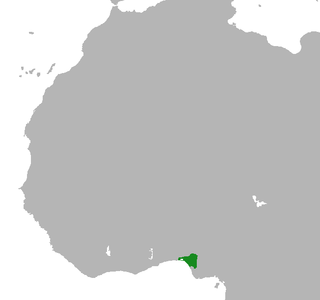
The Kingdom of Benin, also known as the Edo Kingdom or the Benin Empire, was a kingdom within what is now southern Nigeria. It has no historical relation to the modern republic of Benin, which was known as Dahomey from the 17th century until 1975. The Kingdom of Benin's capital was Edo, now known as Benin City in Edo State, Nigeria. The Benin Kingdom was "one of the oldest and most developed states in the coastal hinterland of West Africa". It grew out of the previous Edo Kingdom of Igodomigodo around the 11th century AD, and lasted until it was annexed by the British Empire in 1897.
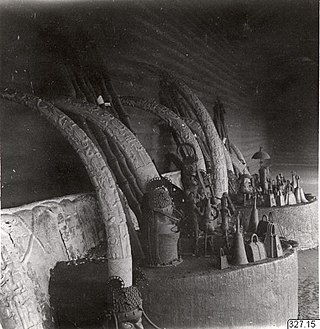
Benin ancestral altars are adorned with some of the finest examples of art from the Benin Kingdom of south-central Nigeria.

The Benin ivory mask is a miniature sculptural portrait in ivory of Idia, the first Iyoba of the 16th century Benin Empire, taking the form of a traditional African mask. The masks were looted by the British from the palace of the Oba of Benin in the Benin Expedition of 1897.
ErhaborOgievaEmokpae, OON, was a renowned Nigerian sculptor, muralist, graphic artist and painter who is regarded as one of the pioneers of modern arts in Nigeria. Some of his notable works include the a bronze replica of the ivory mask of Queen Idia that was used as the official emblem of the Second World Black and African Festival of Arts and Culture and a popular painting of Queen Amina. He is also responsible for the decorations on the four entrances of the National Arts Theatre, in Lagos.
Unuamen also spelt Unuame is an ancient village community by Ovia river in Ovia North-East Local Government Area of Edo State, Nigeria. Unuame is about 15 kilometres (9 mi) from Benin City and 20 kilometres (12 mi) from Benin Airport. Unuame is one of the ancestral homes of Oba Esigie's maternal grandfather and home town to some group of Binis. The people of Unuame have remained loyal to the monarch since the establishment of the ancient Kingdom of Benin. Being a part of the Kingdom of Benin, Unuame is at the heart of the tropical rainforest in the southern part of Nigeria, way to the west of the delta of the Niger River and inland from the coast.

The Iyoba of Benin is an important female titleholder in the chieftaincy system of the Kingdom of Benin, a Nigerian traditional state. She is otherwise known in English as the Queen Mother.
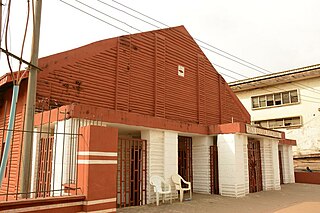
Holy Aruosa Cathedral is a church located at Akpakpava in Benin City, Edo, Nigeria. It was founded by Oba Esigie and Portuguese missionaries. It is commonly called the church of the Oba of Benin and the elderly Binis. It is one of the oldest churches in Nigeria, which can be traced back to the coming of Portuguese. Just as every Abrahamic religion has a sacred book, Holy Arousa Catheral's holy book is known as the Book of Holy Aruosa which was written by the "wise men with dictate, teachings, and sayings of the ancient Benin kingdom."
Uselu is a densely-populated neighborhood of Benin City, Edo State, Nigeria. It is the headquarters of Egor local government area.
Aruan of Udo refers to a Benin mythical prince in the ancient city of Benin, born to Oba Ozolua by Queen Ohonmi.
Igun Street, also known as Igun-Eronmwon Quarters, is a street situated in Benin City, Edo State, Nigeria. This street is renowned for being the residence of the Guild of Benin Bronze and Brass Casters, known as the Igun-Eronmwon. It holds the designation of a UNESCO World Heritage Site. Notably, it stands as the second most frequented tourist attraction within Benin City. Tourists, art dealers, and collectors routinely visit Igun Street to observe the comprehensive process involved in crafting these objects.
Akengbuda was the Oba of Benin from 1750 to 1804. He was the son and successor of Eresoyen, and the father of Obanosa. He is regarded as one of the most powerful and influential obas in the history of the Kingdom of Benin, as he expanded the kingdom's territory, improved its administration, and promoted its arts and culture. He also maintained a strong trade relationship with the Europeans, especially the Portuguese and the British, and acquired firearms and other goods from them. He was known for his military prowess, his diplomatic skills, and his patronage of arts and learning.














